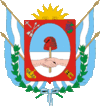Province of Catamarca
| Catamarca | |||
|---|---|---|---|
| Province | |||
|
|||
 Location of Catamarca within Argentina |
|||
| Country | Argentina | ||
| Capital | San Fernando del Valle de Catamarca | ||
| Departments | 16 | ||
| Municipalities | 36 | ||
| Government | |||
| • Governor | Lucía Corpacci (Justicialist - FPV) | ||
| • Legislature | Chamber of Deputies (41) Senate (16) |
||
| • National Deputies |
5 |
||
| • National Senators | Oscar Castillo, Inés Blas, Dalmacio Mera | ||
| Area Ranked 11th |
|||
| • Total | 102,602 km2 (39,615 sq mi) | ||
| Population (2010) | |||
| • Total | 367,828 | ||
| • Rank | 20th | ||
| • Density | 3.6/km2 (9.3/sq mi) | ||
| Demonym(s) | catamarqueño, catamarcano | ||
| Time zone | ART (UTC−3) | ||
| ISO 3166 code | AR-K | ||
| Website | www |
||
Catamarca (Spanish pronunciation: [kataˈmarka]) is a province of Argentina, located in the northwest of the country. The province has a population of 334,568 as per the 2001 census [INDEC], and covers an area of 102,602 km2. Its literacy rate is 95.5%. Neighbouring provinces are (clockwise, from the north): Salta, Tucumán, Santiago del Estero, Córdoba, and La Rioja. To the west it borders Chile.
The capital is San Fernando del Valle de Catamarca, usually shortened to Catamarca. Other important cities include Andalgalá, Tinogasta, and Belén.
Most of Catamarca’s territory of 102,602 square kilometers (2.7% of the country total), is covered by mountains (80%), which can be grouped into four clearly differentiated systems: the Pampean sierras, in the east and center; the Narváez-Cerro Negro-Famatina system, in the west; the cordilleran-Catamarca area of transition, in the western extreme; the Puna, an elevated portion, in the northwest.
Located in an arid and semi-arid climate zone, the scarce water resources determine the human settlement pattern. Agricultural activities are concentrated in the pockets and valleys between the mountains. In the east the population is concentrated around a number of water courses, water being distributed by canals and irrigation ditches.
The province is located with the semi–arid region of Argentina. Mean annual precipitation of the province is around 400 to 500 millimetres (16 to 20 in) which decreases significantly to the west. The province is characterized by the presence of different microclimates based on variations in altitude. In general, there are three different climatic zones found within the province.
...
Wikipedia


